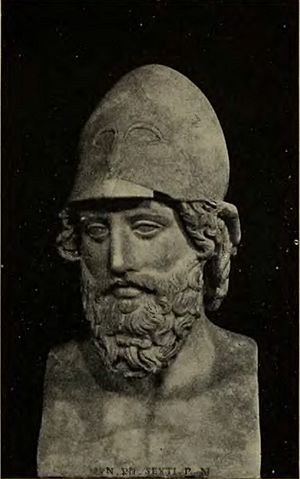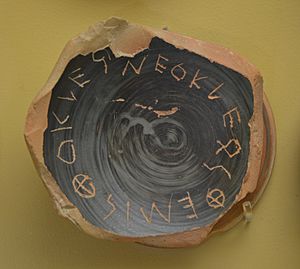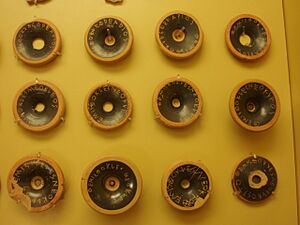Ostracism facts for kids
Ostracism (pronounced: oss-tra-sizm) was a special way the ancient Athenian democracy used to deal with powerful citizens. It allowed the people to send away any citizen from the city of Athens for ten years.
Sometimes, people were ostracized because citizens were really angry at them. But often, it was used as a way to prevent someone from becoming too powerful, like a tyrant. It was a tool to protect the state from anyone seen as a threat. The word "ostracism" is still used today to describe when someone is ignored or excluded by a group.
Contents
How Ostracism Worked
The word "ostracism" comes from the pieces of pottery used for voting. These pieces were called ostraka (singular: ostrakon) in Greek. Broken pottery was very common and free, so it was like using scrap paper. This was much cheaper than papyrus, which was imported from Egypt and very expensive.
Each year, around January or February, the Athenians would gather in their assembly. They would be asked if they wanted to hold an ostracism that year.
If they voted "yes," the ostracism would happen two months later. Citizens would go to a special fenced-off area in the agora (the marketplace). Many people couldn't read or write, so they would tell a scribe the name of the person they wanted to ostracize. The scribe would then scratch the name onto a pottery shard. These shards were piled face down to keep the votes secret.
Nine special officials called Archontes and the council of five hundred watched over the process. They counted the ostraka and sorted the names into piles. The person whose pile had the most ostraka would be banished. However, there had to be at least 6,000 votes in total for the ostracism to be valid.
The person who was ostracized had ten days to leave Athens. If they tried to come back before ten years, they could be put to death. But their property was not taken away, and they didn't lose their status as a citizen. After ten years, they could return to the city without any shame. Sometimes, the assembly could even call an ostracized person back early, especially during emergencies like the Persian Wars. For example, Xanthippus (the father of Pericles) and Aristides were called back before the Persian invasion in 479 BC. Cimon was also called back during an emergency in 461 BC.
Different from Other Athenian Laws
Ostracism was quite different from how Athenian courts worked back then. In an ostracism, there was no specific charge against the person, and they couldn't defend themselves. It was like asking a jury, "Do you want to find someone guilty?" and then, "Who do you want to accuse?"
This process happened only once a year, and only one person could be ostracized. It was a way for the whole community to make a decision, not just one person accusing another. This often helped to reduce political tension instead of making it worse.
Even though ten years of exile was tough, it was a milder punishment compared to what courts could do. Courts could order death, huge fines, taking away property, permanent exile, or losing all citizen rights (called atimia). People who were ostracized were usually rich or noble. They often had friends or connections (called xenoi) in other Greek cities and could still get their money from Athens while they were away. Ostracism was seen as a way to prevent problems, not to punish someone for a crime.

An interesting example of how ostracism worked comes from 190 ostraka found in a well near the Acropolis. These shards had the name of Themistocles on them, who was ostracized before 471 BC. It seems they were written by fourteen different people and were meant to be given to voters. This shows that groups tried to influence the outcome of ostracisms. The two-month gap between the decision to hold an ostracism and the actual vote allowed time for such campaigns or discussions.
This two-month waiting period was important. It stopped people from choosing someone out of immediate anger. It allowed time for public discussion and for people to think about who should be ostracized. This process gave ordinary citizens a sense of power over the most important people in their city. It also made prominent citizens think about how their actions were seen by everyone else.
When Ostracism Was Used
Ostracism wasn't used throughout the entire history of Athenian democracy (from about 506 BC to 322 BC). It was mainly used in the 400s BC. Many historians believe it was started by Cleisthenes, a key reformer who helped create the democracy.
The first person to be ostracized was in 487 BC, nearly 20 years after the practice began. Over the next 60 years, about 12 or more people were ostracized.
Here is a list of some known ostracisms:
- 487 BC: Hipparchos, related to the tyrant Peisistratos.
- 486 BC: Megacles, Cleisthenes' nephew.
- 484 BC: Xanthippus, Pericles' father.
- 482 BC: Aristides.
- 471 BC: Themistocles.
- 461 BC: Cimon.
- 442 BC: Thucydides, son of Melesias.
- 416 BC: Hyperbolus.
Thousands of ostraka have been found in Athens. The second person ostracized, Megacles, is named on 4,647 of these. Ostracism seemed to be popular in three main periods: the 480s BC, mid-400s BC (461–443 BC), and finally 417–415 BC. This suggests that the practice went in and out of fashion.
The last known ostracism was that of Hyperbolus around 417 BC. It wasn't used after the Peloponnesian War. Even though it wasn't actively used in the 300s BC, the question of holding an ostracism was still asked in the assembly each year, but they always voted not to hold one.
Why Ostracism Was Used
Ostracism was used for different reasons over time.
When it first started, after the defeat of the first Persian invasion at Marathon in 490 BC, the people ostracized were often related to the former tyrant Peisistratos. Tyranny and Persian attacks were big threats to Athens' new democracy. Ostracism was used to deal with both.

Later, when the threat of a tyrant was less, ostracism was used to settle big disagreements about policies. For example, in 443 BC, Thucydides, son of Melesias (not the famous historian) was ostracized. He was against Athens becoming an empire and against Pericles' plan to build on the Acropolis using taxes from wars. By ostracizing Thucydides, the Athenians clearly showed what direction they wanted their city to go.
We can't know exactly why each person voted the way they did. Many ostraka have names of people we don't know much about. Maybe some people just voted for someone they disliked. There's a story about Aristides, known as "the Just," who was ostracized in 482 BC. An illiterate citizen asked Aristides himself to write his name on an ostrakon. When Aristides asked why, the man said it was because he was tired of hearing everyone call him "the Just." This shows that sometimes, just being too famous or seeming too arrogant could be enough to get someone's name on an ostrakon.
Why Ostracism Stopped Being Used
The last ostracism, that of Hyperbolus around 417 BC, is a famous story. Plutarch writes that Hyperbolus wanted to get one of his rivals ostracized. But his rivals, Nicias and Alcibiades, worked together and managed to get Hyperbolus ostracized instead! Plutarch says that after this, the people became disgusted with ostracism and stopped using it.
Ostracism also became less common because a new legal process called the graphe paranomon took its place. This was a regular court action where many politicians could be targeted, not just one person a year. The punishments in these courts could also be much harsher.
By the end of the 400s BC, the main threat to democracy wasn't from single tyrants anymore. It was from groups of powerful people (called oligarchs) trying to take over, like the "Four Hundred" in 411 BC and the "Thirty Tyrants" in 404 BC. Ostracism wasn't a good way to defend against these kinds of threats, so it fell out of use.
Similar Practices
Other ancient cities also had forms of ostracism, like Megara, Miletos, Argos, and Syracuse, Sicily. In Syracuse, it was called petalismos because names were written on olive leaves.
A similar idea today is a recall election, where voters can remove an elected official from office.
Unlike modern voting, Athenians didn't have to write names perfectly on ostraka. Many surviving ostraka have funny or rude comments next to the name, and the vote still counted. For example:
- Kallixenes, son of Aristonimos, "the traitor"
- Agasias, "the donkey"
Ostracism Today
Ostracism happens in the animal kingdom and in how people interact today. A social psychologist named Kipling Williams defines ostracism as "any act of ignoring and excluding an individual or groups." It doesn't have to involve shouting or hitting.
Williams says the most common form of ostracism is the silent treatment, where people refuse to talk to someone, effectively ignoring and excluding them.
Online Ostracism
On computer networks like the Internet, ostracism is called "cyberostracism." It's easy to ignore someone in email by not replying. Being ostracized on social media (like being ignored or getting fewer "likes") can make people feel like they don't belong, hurt their self-esteem, and make them feel like they have less control. Cyber-rejection (getting "dislikes") can make people withdraw from social situations. Cyber-ostracism, however, can sometimes lead to more positive social behavior.
Reactions to Ostracism
Studies show two main ways people react to being ostracized. One is to try harder to fit in with the group to be accepted again. The other is to become more challenging or hostile towards the group, trying to get attention instead of acceptance.
Age and Ostracism
Older adults report experiencing ostracism less often, especially around retirement age. No matter the age, being ostracized is strongly linked to negative feelings, less happiness with life, and unhealthy social behavior.
See also
 In Spanish: Ostracismo para niños
In Spanish: Ostracismo para niños


